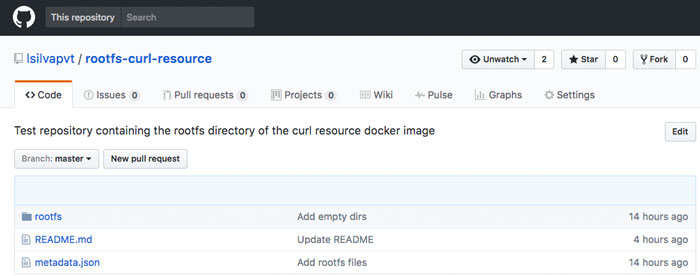Note: the content of this document is still relevant, however see this article for a recent update to S3 resource which makes it easier to bootstrap and run disconnected pipelines
For cases when the access to Docker Hub is not available from the subnet which Concourse is deployed to AND the deployment of an internal Docker Registry may take long or be difficult for any reason, there is a temporary workaround to run Concourse pipelines on that environment: run tasks and community resources using rootfs images stored in a repository.
For that to work, the rootfs image repository (e.g. git) needs to contain two artifacts at its top level:
-
a
rootfsdirectory containing all the files expected from the output of a 'docker export' of the desired container -
a
metadata.jsonfile describing the container'senvvariables and runninguser.
These are the very basic artifacts required for any Docker Image resource in Concourse. See the "how-to" section further below for details on how to generate these artifacts from an existing Docker image.
Here is an example of a rootfs git repository with the required container files exported from the curl-resource image: https://github.com/lsilvapvt/rootfs-curl-resource.
To use that rootfs repository in a pipeline, use the image parameter instead of image_resource when defining a task.
For defining resource types using rootfs repositories, use type: git instead of type: docker-image in the resource_types entries of the pipeline.
Here is how the curl-resource container rootfs repository could be used in a pipeline to run both tasks and resources of a Concourse server disconnected from a Docker registry:
resource_types:
- name: curl-file-resource
type: git
source:
uri: https://github.com/lsilvapvt/rootfs-curl-resource.git
resources:
- name: rootfs-repo
type: git
source:
uri: https://github.com/lsilvapvt/rootfs-curl-resource.git
- name: apache-lucene-5
type: curl-file-resource
source:
url: http://www-us.apache.org/dist/lucene/java/5.5.4/lucene-5.5.4.zip
filename: lucene-5.5.4.zip
jobs:
- name: run-and-get-Apache-Lucene
plan:
- get: rootfs-repo
- get: apache-lucene-5
- task: run-with-rootfs-curl-repository
image: rootfs-repo
config:
platform: linux
inputs:
- name: apache-lucene-5
run:
path: sh
args:
- -exc
- |
find .
The complete pipeline definition file for the sample above can be downloaded from here.
-
Pipeline with task that runs with docker image from a git repository
-
Pipeline with a community resource that is defined with a docker image from a git repository
-
Pipeline with a PivNet community resource that is defined with a docker image from a git repository
The rootfs repositories will have to be pre-populated into the targeted file repository (e.g. GitLab,BitBucket) before the Concourse pipelines can be executed.
The rootfs directory and files can be created from a docker export command, however the metadata.json file is specific to Concourse's Docker images resources.
Because of that, it would be easier to first export a rootfs directory and metadata.json file for a Docker image directly from a Concourse pipeline that has access to Docker Hub, and then save the exported files into the repository that is accessible from the targeted Concourse server which has no access to a Docker registry.
See sample Inspector docker image pipeline that produces the rootfs files for a Docker image in the right format as an output to a task that can be extended to automatically save the files into a another repository.
Look for comments in that file for instructions on how to consume the exported image files.
The techniques described here should only be used for temporary Concourse demonstrations or sample deployments until access to a Docker registry is available from the Concourse server VM's subnet.
